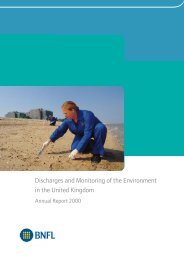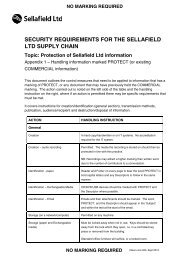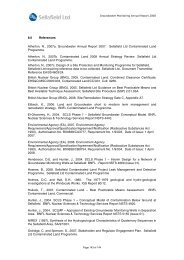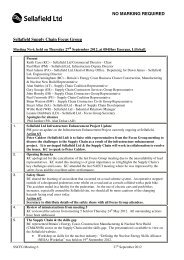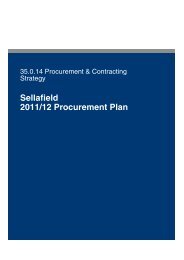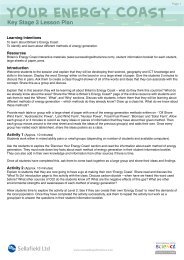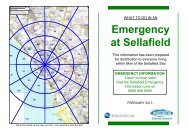Annual Report for 2010/11 and Forward Programme - Sellafield Ltd
Annual Report for 2010/11 and Forward Programme - Sellafield Ltd
Annual Report for 2010/11 and Forward Programme - Sellafield Ltd
Create successful ePaper yourself
Turn your PDF publications into a flip-book with our unique Google optimized e-Paper software.
SSEM/20<strong>11</strong>/4730 June 20<strong>11</strong>wear gloves during retrievals that are removed by correct practice after objects have beenretrieved. Operators do not put h<strong>and</strong> to mouth/face during retrievals while wearing gloves.The wetting process in retrieval prevents blown material that could be inadvertently ingested.5.3.4 Skin contact <strong>and</strong> woundsSkin dose is dependent on activity of an object <strong>and</strong> its time in contact or in close proximitywith the skin. Operators not only take precautions while retrieving objects but once a retrievalis complete (with objects sealed in containers), operators self check with contaminationmonitoring instruments to determine whether activity has become attached to their person,thus eliminating the potential <strong>for</strong> any prolonged contact should it occur. Consequently, thereis extremely low potential <strong>for</strong> skin dose during operations.Entry of material into the body via wound sites is a well recognised potential. Operators arewell versed in practices to seek <strong>and</strong> cover any wound site prior to working with radioactivematerials. In addition, use of gloves <strong>and</strong> st<strong>and</strong>ard work clothing mitigate against any intakevia wound sites.5.3.5 Reassurance by monitoring <strong>for</strong> internal uptakeEven though potential is low <strong>for</strong> intake <strong>and</strong> uptake of material into the body, a regime ofinternal dosimetry is provided <strong>for</strong> each operator. This involves monthly provision of sampleswith analysis on a quarterly basis but with stored samples <strong>for</strong> further analysis should anyuptake be suspected. For operations to date there has not been a dose uptake by anyoperator.5.3.6 Potential of exposure to the publicThe HPA reports cover the period of 3 years between the summers of 2006 <strong>and</strong> 2009. Sincethat time, Groundhog Synergy has been used, with its enhanced capability <strong>for</strong> detection ofalpha-rich objects. This has increased the number of alpha-rich finds, although the majorityof objects are of lower activity than previously seen (Synergy has greater sensitivity thanEvolution2). Thorough assessment of the effects on the public are the subject of furtherstudy but indicators are that finds are not so significant as to expect change in the overallcriteria <strong>for</strong> protection of the public that are described in the HPA reports.5.4 Nuvia dosimetry investigationIn the second half of <strong>2010</strong> Nuvia dosimetry bioassay (i.e. urine <strong>and</strong> faecal) samples from twoworkers engaged in beach monitoring exceeded the urine trigger level (0.2 mBq/day).Nuvia’s internal investigation concluded that a possible explanation <strong>for</strong> the results could bethe chronic ingestion of beach s<strong>and</strong> (with the most significant component being fromenvironmental levels rather than associated with find recovery), combined with thecontamination of urine samples with s<strong>and</strong> from the worker’s h<strong>and</strong>s during sample provision(R<strong>and</strong>les, <strong>2010</strong>).<strong>Sellafield</strong> <strong>Ltd</strong> asked the HPA to carry out an independent investigation to gain reassurancethat there was not a risk to the Nuvia workers. The report (Etherington , 20<strong>11</strong>) found thatthe possibility could not be ruled out that intakes giving rise to committed effective doses inexcess of 1 mSv could have occurred. However, they also found that the possibility could notbe ruled out that the bioassay results, in full or in part, could be explained by samplecontamination.© Nuclear Decommissioning Authority 20<strong>11</strong>. 82



